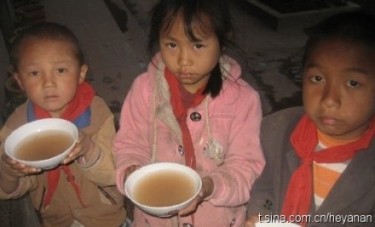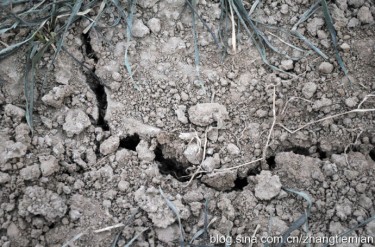This post is part of our special coverage Global Development 2011.
Major agricultural regions in China are facing their worst drought in 60 years.
According to government statistics released January 28, 2011, 7.7 million mu (5,160 million square km) of agricultural land, 2.57 million people and 2.79 million livestock have been hit by the drought. The immediate impact has been rising food prices. Indeed, its implication on food security has prompted the United Nations’ food agency to issue a warning to the world's grain markets.
Despite the drought's serious social and political implications, there hasn't been much concern among opinion leaders on major Chinese web platforms. The online public sphere has been dominated by urban concerns, as Wang Xiaojian points out in Sina micro-blog:
有乡亲上家里问我,是否能让水利部门拨款打口井灌溉农田。我说基本不可能!山东、河北、河南三省130天无有效降雨,冬春小麦基本无望。连续三年粮食欠 收,我妈让我微薄上呼吁,我说无济于事,除非田地开裂、牲畜渴死、危及到人的生命,要不然水利部门基本就不管,微薄上的精英们都在忙着打拐活动。
While a number of microbloggers helped to pass on Wang's message, ultimately there wasn't much of an echo. Sunwen Susan (孙雯-苏三) commented on Wang's message, pointing out that people care more about the property market than the country's agriculture development, as the former is more profitable:
现在河南省的干旱还在持续,开封郊区和郑州相连的地方,那些农田都被用作开发房地产了,他们八成觉得越干越好吧~(2月6日 11:25)
In order to catch people's attention to the severe drought, He Yanan posted a picture showing poor children drinking dirty water to his microblog:

看看这是干旱地区孩子们喝的水…我们正在遭受60年一遇的特大旱灾,不出意外的话,这将是大多数人有生见过最旱的一年,从"点滴"做起,刻不容缓,行动吧,朋友!
Blogger Zhang Teimian also posts some photos showing the situation in his homeland in Shandong in his blog:
没有太多的话,我拍这些照片的时候真的是哭着拍的。。。作为一个农村出生的娃,我深切的知道,庄稼对农民意味着什么。
一直在城市里面,虽然也知道旱情挺严重的,每次打电话回家,爸爸都会叹息,说再不下雨麦子就完了。过年回到农村老家,刚看到麦田,就明白了旱灾的严重,记 得往年春节期间,虽然天气也都很冷,但是麦田里的颜色还都是深绿色的,可是今年却是一片黄绿色。并且今年大年初二就是立春的节气,按照常理,麦苗也要开始 返青了,可是今年。。
走进麦田,看着青青的麦苗,其实很多都已经直接风干了,用手一折就会断掉,近五个月没有降雨,旱情实在太严重了。。。

Now I live in the city but I know that the drought is very serious. Every time I call home, my father keeps telling me that the wheat will die if the rain doesn't come soon. But it wasn't until I went home during the Lunar New Year that I genuinely felt the severe impact of the drought. Last year, although the winter was cold, the wheat was greenish in color. This year, the wheat was yellowish. According to the Lunar Calendar, the second date of the lunar new year was “Spring time”; wheat normally starts grow by then, but not this year…
When walking into the field, the sprouts were totally dry. There hadn't been any rain for five months… the drought is devastating.
Blogger Nanshan Daxian believes that the root cause of water shortage is related to the philosophy of contemporary water resources project and the construction of dams and reservoirs:
我们竟然是走了大禹治水时已经摒弃了的办法。我们使用的是堵截的方式在治水。打开地图看一下就知道,我们早年兴修的水 库无一例外的是在河流的下游把水拦住,然后蓄水成库。当然,兴修发电用的水坝就更是这样了。把江河拦住修水坝,通过提高水位,蓄势发电。这样的治水措施, 让许多的河流干涸了。也让不怎么缺水的地方从此就没有水源。我们要敬佩中国的水利专家,依靠他们的科学思维,终于把几千年来没有治伏的水害给完全的降服 了。然而,他们也作孽呀,是他们把中国变成了世界上最大的缺水国。
On 29 January 2011, the State Council of the People's Republic of China released a document on water resource reform [zh] to address the problem of water supply in rural areas. It is a good sign that the Central Government is now paying attention to the uneven investment on the urban water supply and rural irrigation, the fundamental philosophy of water resource management is yet to be reviewed.
This post is part of our special coverage Global Development 2011.







2 comments
Don’t worry. You haven’t seen nothing yet. China is going to have the worst drought in 61 years in 2011, and the worst in 62 years in 2012. These droughts are self inflicted natural disasters through over exploitation of China’s own natural resources.
And the result of climate change :/ The truth might well be that this is the new normal